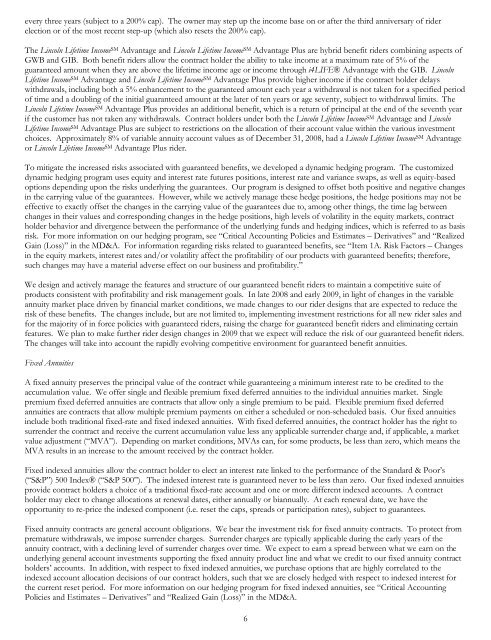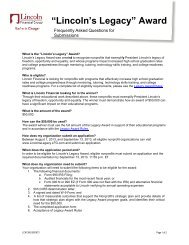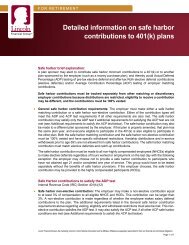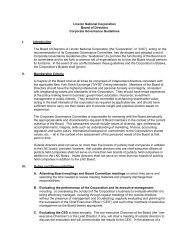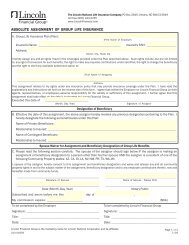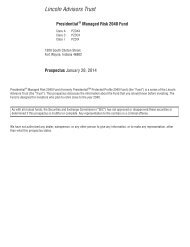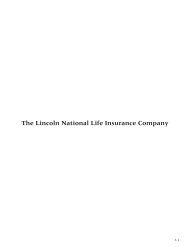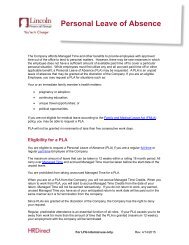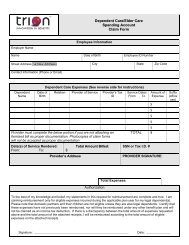2008 Annual Report to Shareholders - Lincoln Financial Group
2008 Annual Report to Shareholders - Lincoln Financial Group
2008 Annual Report to Shareholders - Lincoln Financial Group
Create successful ePaper yourself
Turn your PDF publications into a flip-book with our unique Google optimized e-Paper software.
every three years (subject <strong>to</strong> a 200% cap). The owner may step up the income base on or after the third anniversary of rider<br />
election or of the most recent step-up (which also resets the 200% cap).<br />
The <strong>Lincoln</strong> Lifetime Income SM Advantage and <strong>Lincoln</strong> Lifetime Income SM Advantage Plus are hybrid benefit riders combining aspects of<br />
GWB and GIB. Both benefit riders allow the contract holder the ability <strong>to</strong> take income at a maximum rate of 5% of the<br />
guaranteed amount when they are above the lifetime income age or income through i4LIFE® Advantage with the GIB. <strong>Lincoln</strong><br />
Lifetime Income SM Advantage and <strong>Lincoln</strong> Lifetime Income SM Advantage Plus provide higher income if the contract holder delays<br />
withdrawals, including both a 5% enhancement <strong>to</strong> the guaranteed amount each year a withdrawal is not taken for a specified period<br />
of time and a doubling of the initial guaranteed amount at the later of ten years or age seventy, subject <strong>to</strong> withdrawal limits. The<br />
<strong>Lincoln</strong> Lifetime Income SM Advantage Plus provides an additional benefit, which is a return of principal at the end of the seventh year<br />
if the cus<strong>to</strong>mer has not taken any withdrawals. Contract holders under both the <strong>Lincoln</strong> Lifetime Income SM Advantage and <strong>Lincoln</strong><br />
Lifetime Income SM Advantage Plus are subject <strong>to</strong> restrictions on the allocation of their account value within the various investment<br />
choices. Approximately 8% of variable annuity account values as of December 31, <strong>2008</strong>, had a <strong>Lincoln</strong> Lifetime Income SM Advantage<br />
or <strong>Lincoln</strong> Lifetime Income SM Advantage Plus rider.<br />
To mitigate the increased risks associated with guaranteed benefits, we developed a dynamic hedging program. The cus<strong>to</strong>mized<br />
dynamic hedging program uses equity and interest rate futures positions, interest rate and variance swaps, as well as equity-based<br />
options depending upon the risks underlying the guarantees. Our program is designed <strong>to</strong> offset both positive and negative changes<br />
in the carrying value of the guarantees. However, while we actively manage these hedge positions, the hedge positions may not be<br />
effective <strong>to</strong> exactly offset the changes in the carrying value of the guarantees due <strong>to</strong>, among other things, the time lag between<br />
changes in their values and corresponding changes in the hedge positions, high levels of volatility in the equity markets, contract<br />
holder behavior and divergence between the performance of the underlying funds and hedging indices, which is referred <strong>to</strong> as basis<br />
risk. For more information on our hedging program, see “Critical Accounting Policies and Estimates – Derivatives” and “Realized<br />
Gain (Loss)” in the MD&A. For information regarding risks related <strong>to</strong> guaranteed benefits, see “Item 1A. Risk Fac<strong>to</strong>rs – Changes<br />
in the equity markets, interest rates and/or volatility affect the profitability of our products with guaranteed benefits; therefore,<br />
such changes may have a material adverse effect on our business and profitability.”<br />
We design and actively manage the features and structure of our guaranteed benefit riders <strong>to</strong> maintain a competitive suite of<br />
products consistent with profitability and risk management goals. In late <strong>2008</strong> and early 2009, in light of changes in the variable<br />
annuity market place driven by financial market conditions, we made changes <strong>to</strong> our rider designs that are expected <strong>to</strong> reduce the<br />
risk of these benefits. The changes include, but are not limited <strong>to</strong>, implementing investment restrictions for all new rider sales and<br />
for the majority of in force policies with guaranteed riders, raising the charge for guaranteed benefit riders and eliminating certain<br />
features. We plan <strong>to</strong> make further rider design changes in 2009 that we expect will reduce the risk of our guaranteed benefit riders.<br />
The changes will take in<strong>to</strong> account the rapidly evolving competitive environment for guaranteed benefit annuities.<br />
Fixed Annuities<br />
A fixed annuity preserves the principal value of the contract while guaranteeing a minimum interest rate <strong>to</strong> be credited <strong>to</strong> the<br />
accumulation value. We offer single and flexible premium fixed deferred annuities <strong>to</strong> the individual annuities market. Single<br />
premium fixed deferred annuities are contracts that allow only a single premium <strong>to</strong> be paid. Flexible premium fixed deferred<br />
annuities are contracts that allow multiple premium payments on either a scheduled or non-scheduled basis. Our fixed annuities<br />
include both traditional fixed-rate and fixed indexed annuities. With fixed deferred annuities, the contract holder has the right <strong>to</strong><br />
surrender the contract and receive the current accumulation value less any applicable surrender charge and, if applicable, a market<br />
value adjustment (“MVA”). Depending on market conditions, MVAs can, for some products, be less than zero, which means the<br />
MVA results in an increase <strong>to</strong> the amount received by the contract holder.<br />
Fixed indexed annuities allow the contract holder <strong>to</strong> elect an interest rate linked <strong>to</strong> the performance of the Standard & Poor’s<br />
(“S&P”) 500 Index® (“S&P 500”). The indexed interest rate is guaranteed never <strong>to</strong> be less than zero. Our fixed indexed annuities<br />
provide contract holders a choice of a traditional fixed-rate account and one or more different indexed accounts. A contract<br />
holder may elect <strong>to</strong> change allocations at renewal dates, either annually or biannually. At each renewal date, we have the<br />
opportunity <strong>to</strong> re-price the indexed component (i.e. reset the caps, spreads or participation rates), subject <strong>to</strong> guarantees.<br />
Fixed annuity contracts are general account obligations. We bear the investment risk for fixed annuity contracts. To protect from<br />
premature withdrawals, we impose surrender charges. Surrender charges are typically applicable during the early years of the<br />
annuity contract, with a declining level of surrender charges over time. We expect <strong>to</strong> earn a spread between what we earn on the<br />
underlying general account investments supporting the fixed annuity product line and what we credit <strong>to</strong> our fixed annuity contract<br />
holders’ accounts. In addition, with respect <strong>to</strong> fixed indexed annuities, we purchase options that are highly correlated <strong>to</strong> the<br />
indexed account allocation decisions of our contract holders, such that we are closely hedged with respect <strong>to</strong> indexed interest for<br />
the current reset period. For more information on our hedging program for fixed indexed annuities, see “Critical Accounting<br />
Policies and Estimates – Derivatives” and “Realized Gain (Loss)” in the MD&A.<br />
6


